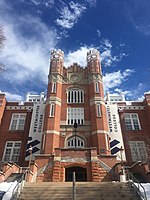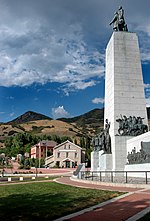Highland High School (Utah)
1956 establishments in UtahEducational institutions established in 1956International Baccalaureate schools in UtahPublic high schools in UtahSchools in Salt Lake City
Highland High School is a high school in Salt Lake City, in the U.S. state of Utah, that opened in 1956 and has a student body of 1,546. It is located at 2166 South 1700 East, next to Sugar House Park, and is part of the Salt Lake City School District. The current principal is Jeremy Chatterton.
Excerpt from the Wikipedia article Highland High School (Utah) (License: CC BY-SA 3.0, Authors).Highland High School (Utah)
Sugarhouse Park East Road, Salt Lake City
Geographical coordinates (GPS) Address External links Nearby Places Show on map
Geographical coordinates (GPS)
| Latitude | Longitude |
|---|---|
| N 40.723611111111 ° | E -111.84361111111 ° |
Address
Highland High School
Sugarhouse Park East Road
84106 Salt Lake City
Utah, United States
Open on Google Maps







